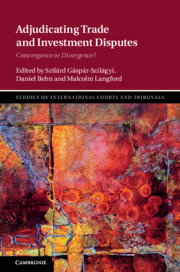Book contents
- Adjudicating Trade and Investment Disputes
- Studies on International Courts and Tribunals
- Adjudicating Trade and Investment Disputes
- Copyright page
- Contents
- Figures
- Tables
- Editors and Contributors
- Preface and Acknowledgements
- 1 Assessing Convergence in International Economic Disputes – A Framework
- Part I Dispute System Design
- 2 Investment Chapters in PTAs and Their Impact on Adjudicative Convergence
- 3 The EU Investment Court System and Its Resemblance to the WTO Appellate Body
- 4 Entry Rights and Investments in Services: Adjudicatory Convergence between Regimes?
- Part II Use of Precedent across Regimes
- Part III Interpretive Powers and Adjudicative Behaviour
- 11 Epilogue: ‘Convergence’ Is a Many-Splendored Thing
- Index
3 - The EU Investment Court System and Its Resemblance to the WTO Appellate Body
from Part I - Dispute System Design
Published online by Cambridge University Press: 25 June 2020
- Adjudicating Trade and Investment Disputes
- Studies on International Courts and Tribunals
- Adjudicating Trade and Investment Disputes
- Copyright page
- Contents
- Figures
- Tables
- Editors and Contributors
- Preface and Acknowledgements
- 1 Assessing Convergence in International Economic Disputes – A Framework
- Part I Dispute System Design
- 2 Investment Chapters in PTAs and Their Impact on Adjudicative Convergence
- 3 The EU Investment Court System and Its Resemblance to the WTO Appellate Body
- 4 Entry Rights and Investments in Services: Adjudicatory Convergence between Regimes?
- Part II Use of Precedent across Regimes
- Part III Interpretive Powers and Adjudicative Behaviour
- 11 Epilogue: ‘Convergence’ Is a Many-Splendored Thing
- Index
Summary
This chapter analyses the alternative scenarios of how a multilateral investment court could come about, including an assessment of existing international frameworks that are likely to host that institution (e.g. the WTO, OECD, ICSID and UNCITRAL). The author argues that the EU’s active engagement in the field could fall victim to its own success – if it ever becomes successful, that is. If the proposed ICS turns out to be effective, efficient and accepted as more legitimate than investor-state arbitration, it might in fact inhibit the efforts of establishing a multilateral investment court. Alternatively, the increasing use of these instruments could result in a creeping multilateralization, creating a quasi-multilateral network of treaty-centred investment courts, a shrine to Western neoliberal values. A glimpse of hope, on the other hand, might come as a spin-off effect of current developments, should existing frameworks such as ICSID, UNCITRAL and the WTO rise to the occasion.
- Type
- Chapter
- Information
- Adjudicating Trade and Investment DisputesConvergence or Divergence?, pp. 62 - 91Publisher: Cambridge University PressPrint publication year: 2020

